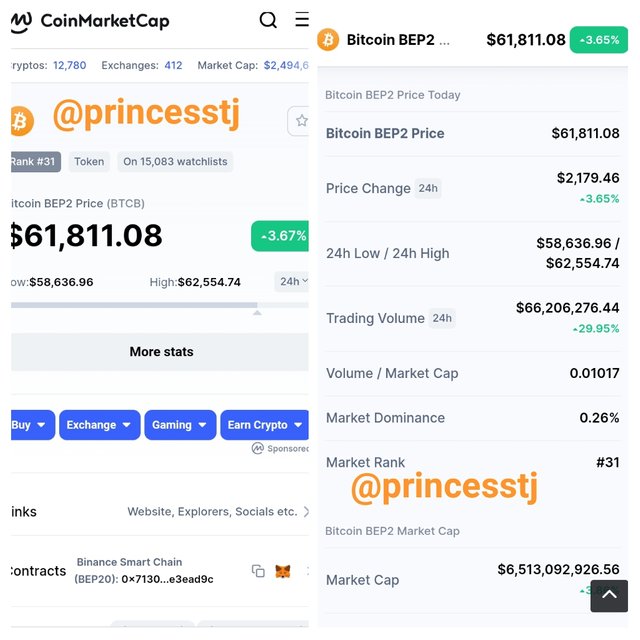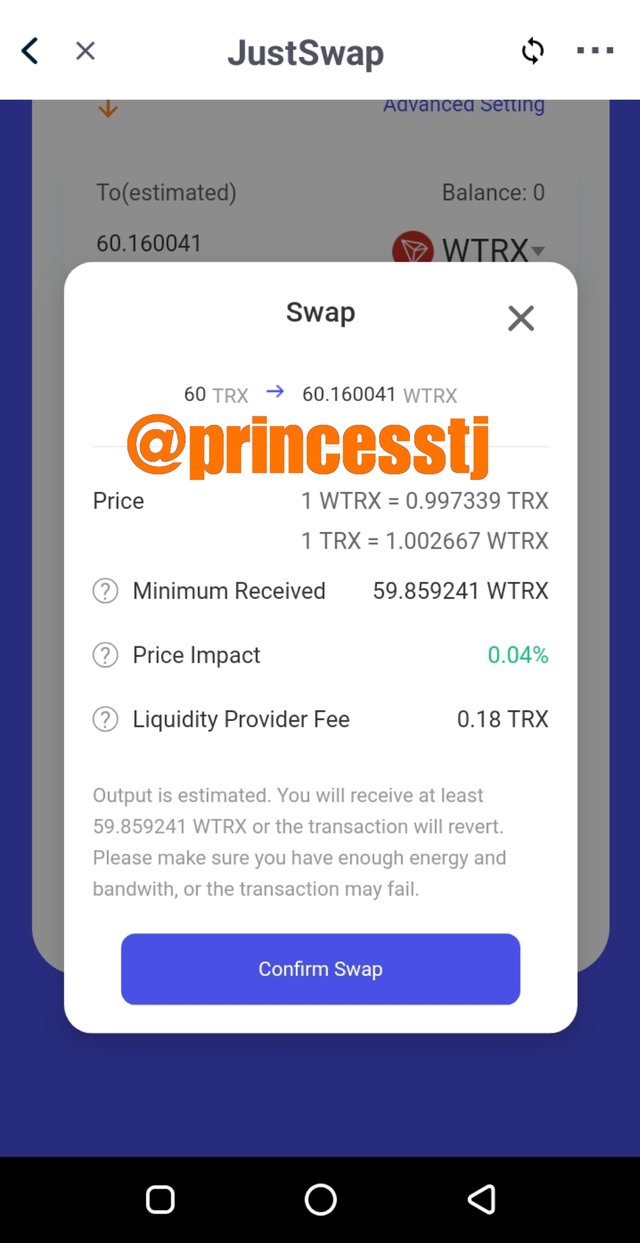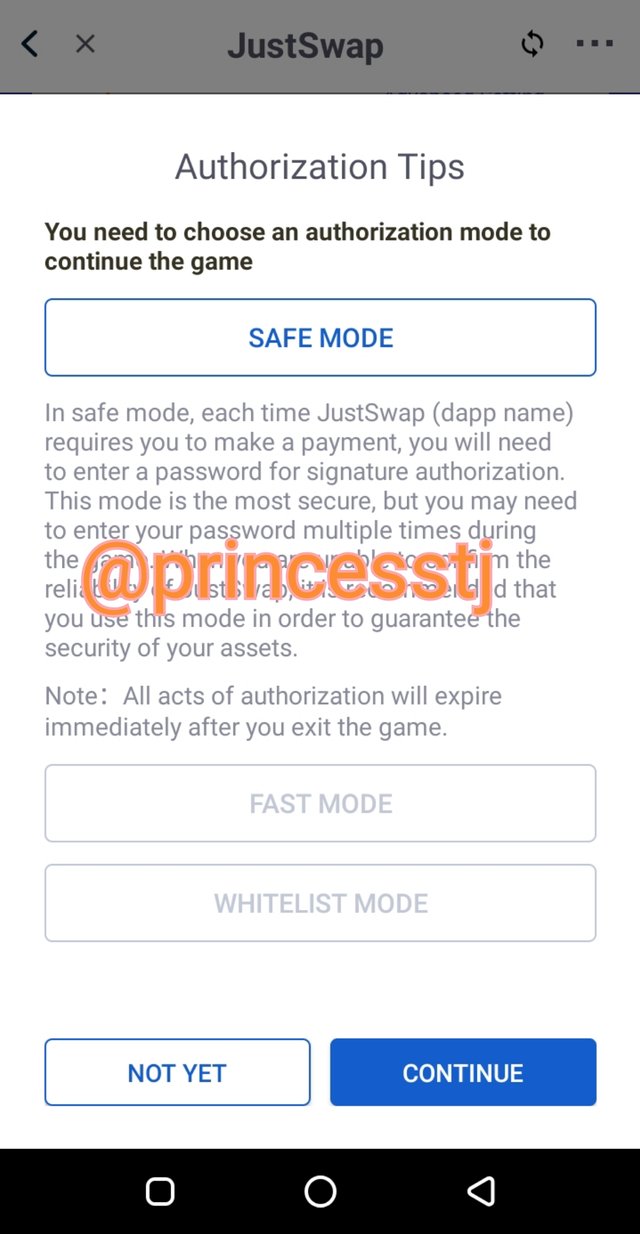Wrapped Tokens - Crypto Academy / S4W6 - Homework post for pelon53
1.- Name at least 2 Blockchains that use the Wrapped BTC, excluding Ethereum, and show screenshots. Explain.
Wrapped tokens are cryptocurrency tokens that represent a native token of another blockchain. They are wrapped so that they can be used for operations in another blockchain. This could be likened to a ticket that we buy in order to access a cinema when we want to see a movie. Without a movie ticket, we will not be allowed to enter the cinema.
In this same way the ETHER, which is a native token of the Ethereum blockchain cannot be used for transactions in Tron network, unless it is exchanged to a wrapped token
Now, let's look at two blockchains that use wrapped tokens.
1. Binance Smart Chain:
The Binance Smart Chain is a blockchain-based platform which exist mainly for the decentralized exchange of tokens using smart contracts. It also uses proof of stake authority and dual technology. This aids in the transfer of tokens to the Binance chain. With this, Binance BEP8 and BEP2 can be successfully swapped to BEP20.
The Binance Smart Chain enables developers to execute the development of DApps in the chain with ease. Also, Projects can successfully be deployed from Ethereum to the Chain because the smart contract function was made to be compatible with Ethereum virtual machine (EVM).
Binance Smart Chain has also solved the interoperability issue facing blockchains by introducing some Wrapped tokens to the chain. The smartchain has a wrapped Bitcoin which price is pegged to the current price of Bitcoin. This wrapped Bitcoin is a portable representation of Bitcoin that can be used in the Smart Chain for transactions.

From the screenshot taken in Coinmarketcap, the details of the Binance smart chain Bitcoin, BTCT are shown such as the price, market capitalisation, token rank, circulating supply, and so on.
The Tron Blockchain
The Tron Blockchain also has some wrapped tokens on the system such as WBTC and WETH which could be used to transact within the system. Tron is a decentralized ecosystem that was built by Justin Sun. This ecosystem has some projects that run on it. It makes use of some tokenized coins known as TRC-20.
Just like the Binance Smart Chain, Tron also does not support native currencies of other blockchains. This means that those coins are not compatible with the Tron Blockchain. However, to solve this problem of incompatibility, wrapped tokens were introduced.
An example is the wrapped BTC whose value of $62,028.44 is the same as original BTC at the time of writing. It can be seen below, the market capitalisation of WBTC on tronscan. The WBTC has a capitalisation of $6196022.3 and a supply of 99.89 WBTC tokens.

2.- What is the difference between the wETH of the Ethereum platform and the wETH of the TRON platform? Explain.
Differences Between Tron's WETH and Ethereum's WETH
- The WETH of the Tron Blockchain is a TRC-20 token which is a tokenized Ethereum. It has TRC-20 standard. While the WETH of the Ethereum blockchain is an ERC-20 token, a tokenized Ethereum with ERC-20 standard
- The WETH of Tron requires burning in order to swap it back to ETH. Whereas, the WETH of Ethereum doesn't need to burn the Tokens before converting it back to ETH. This is because Ethereum is its original home.
- There is no custodian for minting and burning the Wrapped Ethereum of the Ethereum blockchain. This is so because that is the native and original blockchain for ETH. But for Tron, there is always an external custodian that will mint the token and also burn them.
- Transactions carried out with Tron's WETH are cheaper while that of Ethereum WETH are more expensive.
3.- Make an investment of at least $ 5 of a Wrapped token. Explain the process with screenshots. You can use the JustSwap platform.
The Process of Converting TRX to WTRX
I used the JustSwap platform of TronLink wallet for the transaction. Below are the processes involved in it.
First Step: First of all, I logged into TronLink wallet where I clicked on "Discover" for Decentralized applications to appear.

Second step: When the exchanges appeared, I selected JustSwap and the platform was launched.

Third Step: I tapped the swap button and the swap page was launched as well.

Fourth Step: I was asked to choose a token I'm swapping from, and the one I'd be converting it to which I selected TRX and WTRX respectively.

Fitth step: The price of WTRX to TRX was displayed and I clicked on "Confirm" to continue.

Sixth step: I was actually doing the swap for the first time, so I needed to do an authorization and choose a safe mode. I did and clicked on "Done".

I chose a password for the transactions.

Final step: My conversion process was completed.

4.- Explain in detail the Wrapped token of the TRON Blockchain. Show screenshot.
The tron ecosystem has its own native token known as TRX. It is an isolated blockchain that does not accept external coins of other blockchains. This means that for interoperability to take place, there has to be a minting process of changing the form of the external coin to a TRC-20 token. Some of these tokens already exist in the Tron network. There are two different categories of wrapped token in the Tron network. The ones that require external custodian and the ones that do not.
Wrapped BTC (wBTC) and Wrapped Ethereum (wETH):
The wrapped Bitcoin and wrapped Ethereum requires an external custodian, which is BitGo. BitGo is a group that entered into a partnership with the founder of Tron, Justin Sun in September, 2020. This partnership saw to the introduction of Bitcoin into the Tron network as a TRC-20 token. The WBTC has the TRC-20 standards and facilitates interoperability in the ecosystem. The WBTC is currently being used for transactions at the rate of $61,810.416 which is in a ¹/¹ rate with BTC.

Screenshot taken in Tronscan
The wrapped Ethereum (wETH) is also on the Tron network. This token represents the original Ether in the Tron network. Since the original Ether coin cannot be used in the network, the wrapped ETHER was made in TRC-20 standard to replace ETHER. This token also have a ¹/¹ rate with ETHER. Looking at the details of this token in tronscan, the wETH has a circulating supply of 1,998.5988 tokens and its current rate is $4,743.035

Screenshot from Tronscan
Apart from these tokens, there are other Tokens that are non-custodial wrapped token still on the Tron network.
They are the wrapped TRX and wrapped BTT. These tokens were developed in the Tron blockchain meaning that it is not an external body that is responsible for their creation and burning. They correspond with TRX, which is the native token of the Tron network. wTRX is a wrapped TRC10 which complements the TRC-20 tokens.
The wrapping up gives it the ability to carryout transactions and function as a TRC-20 token. The details of the wTRX token as shown in tronscan are displayed below; such as a rate of $0.10 and a market capitalisation of $1,767,876,733.66.
 Screenshot from Tronscan
Screenshot from Tronscan
BTT is a token made in the standard of TRC10. Just like the wTRX, wrapping it gives it a TRC-20 token functionality. wBTT has a current rate of $0.0036 and a circulating supply 44,360,765,330.1962. Other details can be seen in the screenshot below.

Screenshot from Tronscan
5.- What is to mint a Wrapped token? What is burning a Wrapped token? What is your function? Create an example explaining the process.
Minting a Wrapped Token
Minting a wrapped token in summary is the process of wrapping a native token, that is, changing its form to a tokenized dorm such that it can be accepted for use in a different blockchain. For instance, for Bitcoin to be used in Tron, the currency has to be converted into a wrapped token (WBTC), with TRC-20 standards, so that interoperability will be effective.
In order to convert a cryptocurrency such as Bitcoin or Ethereum to a wrapped token, there have to be a merchant and a custodian. The person who wants to receive the token in its blockchain is the merchant while the one responsible for converting the coin is the custodian.
Another duty of the custodian asides conversion is to maintain the stability of that coin. So the merchant notifies the custodian, they enter into a contract, the merchant sends the coin that is to be converted, the custodian converts it and the merchant receives it back. Then that wrapped coin could be freely used for efficiency.
The Process of Burning a wrapped token/Functions
This is simply the process of converting the wrapped token back. Just like in the previous process, the merchant will still send the token back to the custodian, who will burn and release the currency that was locked back to the merchant. This processes are not too difficult to understand.
Now, the benefits/functions of burning a token is to avoid double usage of the coin. The same way we burn our clothes and they are forever destroyed, that is the same way the wrapped tokens are destroyed when we get our native coin back.
An example of minting and Burning process
If Smith has ETHER and is looking out for transactions on the Tron blockchain, Smith has only one option, which is to mint the ETHER because he can't use it on the Tron blockchain. So Smith will deposit the ETHER in an exchange, and then send a request for the coin to be swapped.
The exchange will then forward this request alongside the ETHER to a custodian, which is a group of company that is in partnership with Tron.
The custodian will then receive the coin and the request, but a smart contract must be entered. Once this contract is executed, the custodian will lock the ETHER and release a wrapped ETHER (WETH). This wrapped ETHER will be sent back to the merchant exchange where Smith will get a corresponding amount of WETH.
Once Smith is okay with the transactions and wishes to convert the wrapped ETHER back to the normal Eth, he will again send a notification through the merchant to the custodian. They will destroy (burn) the WETH and then release the Eth that was locked out for Smith through the merchant.
Conclusion
The introduction of the process of wrapping a token is really great. People can now swap their major coins like Bitcoin and Ethereum to a wrapped token that would be accepted in the blockchain of their choice. This can be done without being scared of losses and reduction in value. Whatever the case is, wrapped tokens have come to stay, with the functionality of facilitating interoperability between blockchains. It was a great experience learning and putting into practice.
Thank you professor @pelon53 once again for this one.
